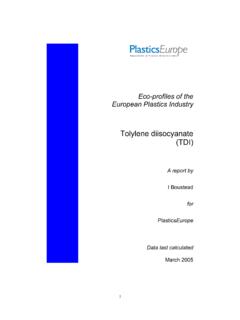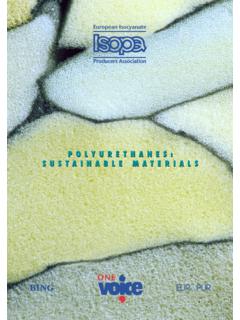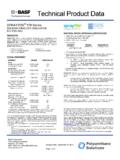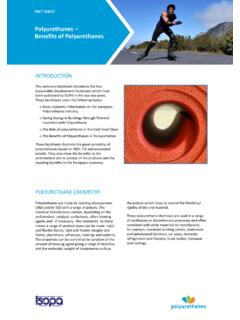Transcription of RECYCLING AND RECOVERING POLYURETHANES
1 fact sheet RECYCLING AND RECOVERING POLYURETHANES . Rebonded Flexible Foam Bonded foam, or rebond, is a moulded polyurethane product made from pieces of shredded flexible polyurethane foam, held together with a binder. Its relative high density and excellent resilience make it suitable for applications including vibration sound dampening, flooring, sport mats, cushioning, packaging and carpet underlay. In fact , rebond has been in use for decades. Up to 50 000 tonnes of rebonded foam are processed each year in Western Europe and new applications are constantly being developed. Shredder Mixer Hopper Cut off Steam outlet Auger Conveyer press Completed rebond foam blocks Binder Steam inlet Typical bonded foam equipment using continuous moulding process Bonded foam properties can be varied over a wide range by careful selection of base material, particle size, compression ratio, type and quantity of the binder.
2 As a consequence, rebonded flexible foam is gaining acceptance in applications which so far could not be satisfied by virgin foam material. The Process foam collection and sorting shredding coating with adhesive binder compression to desired density and shape activation of adhesive binder curing of adhesive binder converting of rebonded foam parts JUNE 2001. Typical bonded foam equipment using batch moulding process Prepolymer Foam Shredder Preparation Reactor Shredded Foam Transfer System Drive Spray Nozzle Shredded Foam Storage Hopper Agitator Blend Tank Foam Completed Rebond Foam Blocks Mould Steam to Jacket Hydraulic Ram Condensed to Waste Water Treatment Foam pieces from various sources - production trim and The ISOPA fact sheet Options in Practice lists post-consumer waste - can be suitable for rebonding, companies which are practicing foam rebonding.
3 Although in practice production trim and cuttings are by The technologies used vary according to the market far the most commonly processed. Granulators and requirements and the final use of the rebond articles. flock-mills are normally used to shred the foam into pieces approximately one centimeter in diameter. There Rebonding of polyurethane foam can be carried out are other technologies available to handle large foam through batch or through continuous moulding. The pieces by cutting them into very thin strips, which can foam blocks are further processed to fabricate parts and then be reduced into smaller pieces. articles, resulting in trim which in turn can be reused in 2. the process. Rebonding is also applied in the moulding- Typical physical properties to-final-shape technology which allows processors to of rebonded foam optimize material use and cost.
4 Density kg/m3 60 - 300. From a storage hopper, the small foam pieces are fed into Tensile strength kPa 40 - 150. a blend tank by means of an Archimedean screw. In the Elongation at break % 40 - 90. tank, the foam is sprayed/mixed with a polyurethane CLD hardness at 10% compression 4 - 20. binder. Once coated with the binder, the foam is fed at 25% 5 - 50. into a mould. In the batch process, a rectangular or at 50% 15 - 150. cylindrical mould is used. A piston compresses the foam in the mould to the desired density. Steam is then introduced to activate and cure the binder. After curing, the mould can be opened, the rebond removed from it and allowed to dry. SUGGESTED READING. Rebonded Foam on the Basis of an NCO Prepolymer', Bayer; March 1987. Basics of Bonded Foam', Dow Plastics, 1991. (Form No.)
5 109-01506-591 SMG). Remotec Product Information', Hennecke Polyurethan- Anlagetechnik, October 1995. Where a continuous moulding process is used, the foam binder mixture is deposited from the blend tank onto a moving conveyor. Another conveyor is positioned above this so that the mixture is compressed as it passes between them. Conventional cutting and peeling processes are used to Additional information can be obtained from: turn the rebond into finished products. EUROPUR Secretariat c/o Square Marie-Louise 49. Rebond characteristics B-I040 Brussels, Belgium. Tel: +32 2 238 98 69. The quality of rebond depends on several factors like: Fax: +32 2 238 99 98. the types and grades of the foams used the particle size and uniformity of the shredded foam pieces RECYCLING companies are kindly invited to the density required of the end product submit to ISOPA their references in case they are the quality of the binder active in practicing PU RECYCLING and recovery.
6 The binder / foam ratio 3. 2. sheet . ISOPA has produced a brochure and a series of fact sheets on polyurethane RECYCLING options. The following are now available : RECYCLING POLYURETHANES (Brochure). PU in Perspective Densification/Grinding Re-use of Particles Rebonded Flexible Foam Adhesive Pressing/Particle Bonding Regrind/Powdering Compression Moulding Chemolysis Feedstock Recovery Energy Recovery Energy Recovery from Flexible PU Foams Recovery of Rigid polyurethane Foam from Demolition Waste Options in Practice ISOPA EUROPUR c/o FIC. Avenue E. van Nieuwenhuyse 4, Box 9 Square Marie-Louise, 49. Brussels B-1160 1000 Brussels Belgium Belgium Tel: +32 2 676 74 75 Tel: +32 2 238 98 69. Fax: +32 2 676 74 79 Fax: +32 2 238 99 98. E-mail: website: ISOPA - the European Isocyanates Producers' Association - is an affiliated organisation within the European Chemical Industry Council (CEFIC).
7 Since the original polyurethane material has not been designed for use in articles in contact with food, relevant EU (such as Directives 90/128/EEC) and national legislations need to be consulted, if and when recycled materials are used to manufacture articles and goods for possible direct and indirect food contact. The information contained in this publication is, to the best of our knowledge, true and accurate, but any recommendation or suggestions which may be made are without guarantee, since the conditions of use and the composition of source materials are beyond our control. Furthermore, nothing contained herein shall be construed as a recommendation to use any product in conflict with existing patents covering any material or its use. June 2001.








